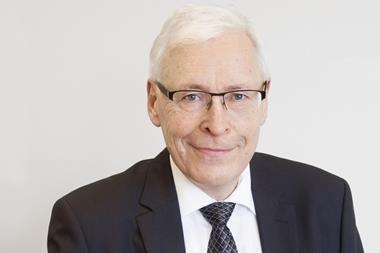Fiduciary management is a way of organising the management of sizeable investment portfolios. The growing interest it has aroused reflects the beginnings of an historic shift in the approach many institutions are taking to investment management.
After several decades of expanding the range of actors involved in managing an institutional portfolio, there is growing recognition of the problems created by the participation of this large cast of characters; when many are concerned, no one is fully responsible.
Fiduciary management can be viewed in Hegelian terms: thesis, antithesis, and synthesis. In the context of investment management, the thesis was the balanced manager: as institutional investment was created more than a century ago, the initial response was to turn money over to a single manager who would select all investments, manage the portfolio and take full responsibility for all investment issues and decisions.
Antithesis followed half a century later in the form of modern portfolio theory that encouraged the view that more diversification was beneficial and that specialised managers could achieve better results than generalists. As a result institutions put together armadas of managers under the guidance of investment consultants but this in turn created problems in achieving comprehensive risk management, strategic decision-making and effective organisational governance.
The fiduciary manager is the synthesis. It oversees a decentralised, outsourced array of investment managers, but also centralises responsibility in one person or organisation.
The functions that fiduciary managers should provide include advising the board of the plan sponsor, constructing an efficient investment portfolio, selecting asset managers and monitoring their performance and reporting on the investment process.
For all but the largest pension funds, the fiduciary manager can play an important role in bringing valuable advice and counsel. It offers a pension fund a unique combination of expertise and an ongoing commitment to the overall management of the plan.
the fiduciary can inject his expertise into a range of areas within the plan management process, including asset/liability studies, balancing risk and return considerations and generally educating plan sponsor staffs and trustees about the range of issues confronting them.
The asset/liability study is the area where a fiduciary can especially prove his value. The study should be the starting point of the institutional investment process. It needs to be undertaken by a specialist who is able to bring together actuarial principles with an understanding of the vagaries of financial markets. A fiduciary manager can help provide critical information needed for the study and evaluate the outcome of such a study. He can also generate ideas about the investment side of the study by, for example, offering new ideas about asset classes, additional data about correlations between investments and so on. His role in asset/liability modelling grounds the plan in reality.
Even more important is a fiduciary's ability to help the fund decide what exactly to do with the outcome of the study. A pension fund's board, which generally has limited knowledge of and experience in investing, should choose a risk budget which is stated in neutral terms, such as a maximum probability of having a certain amount of underfunding. But in reality, the board often selects a strategic asset mix and a permissible level of risk for asset managers that are too aggressive or not aggressive enough.
This situation can be avoided by having the fiduciary manager translate the neutrally defined risk budget into investment terms. The board confines itself to decisions it can oversee and the fiduciary is responsible for the appropriate translation of this neutral risk budget into budgetary limits that asset managers can work with.
Once a plan sponsor has examined its assets and liabilities, it needs to consider the risks and returns associated with various investment approaches. There is a fundamental dichotomy between approaches that essentially seek to match assets and liabilities and those that seek to achieve higher investment returns to reduce the costs and contributions faced by the plan sponsor.
As a result of the introduction of more stringent funding regulations there is a growing number of pension funds that seek to match assets and liabilities as closely as possible. This involves such approaches as adding more and longer-duration fixed income investments at the expense of equities in order to narrow the so-called duration gap.
The advantages of diversification among asset classes and the prospect of generating higher returns are increasingly sacrificed for lower risk. Indeed, it is no exaggeration to say that security and peace of mind for the board of an institutional investor are gained at the expense of future retirees.
Once a plan has come to grips with the broad issues associated with its investing approach it can formulate the specifics. Whatever approach is employed, the fiduciary manager can play a significant role in putting together an investment portfolio.
In earlier times, a portfolio was simply an aggregation of discrete investment ideas that seemed to hold promise. These days, it is supposed to be ‘constructed' on a top-down basis. The starting point is an allocation of assets among a set of asset classes, followed by sub-allocations within some of them. Careful attention is paid to achieving diversification and managing risks, in a world in which correlations are different and may vary over time.
All of these tasks can benefit from the involvement of a fiduciary manager as portfolio construction is a highly complicated matter.
A fiduciary brings expertise to these tasks as well as a holistic approach that ensures the broad needs of the plan sponsor are not lost in the details associated with the various aspects of portfolio construction. But it should be stressed that the fiduciary can advise, but cannot decide. The choice of the investment approach, the number of asset classes and their weights in the portfolio are to be decided by the fund and these decisions cannot be delegated.
Selecting and overseeing investment managers is another important role for the fiduciary manager. The allocation of assets among a specific set of asset classes needs to be followed by mandating specialised investment managers to actually invest the funds that have been allocated to each asset class or category of investments.
The task of defining the specialties to pursue and identifying the best managers for each of those specialties is one that the fiduciary manager can undertake on behalf of an institutional investor's board. He can locate the best managers within these categories. The choices are based on characteristics of the asset managers and their organisations as such.
However, it is not only necessary to scrutinise individual managers but also to examine the combinations of managers to assess the overall risk return pattern they are likely to generate.
Another task is measuring and benchmarking risk and return in all their facets. It is a tenet of modern management that every aspect of any managerial task should be measured and monitored to evaluate how well it is being performed.
The fiduciary manager's task is to help the plan sponsor choose the right measuring rods so the fund can understand the results it is getting and then help the fund choose the right benchmarks so it can also understand the meaning of those results. Among the standard questions in managing an activity are what returns have been obtained from various investments, and what should be thought of those returns, are they better than average, are we doing better than other similarly situated funds, what are the sources of the results we are getting, are the risks we are taking being rewarded appropriately and what can we do to improve our results?
But all require the use of specific instruments and approaches when applied to investment management. The fiduciary brings the knowledge and experience required to assist an institutional investor create the appropriate measurement function and build the feedback loop that makes it possible for past results to be interpreted and used to improve future results.
The last of the essential task for a fiduciary is reporting. Control of the board of the pension fund is impossible without the fiduciary reporting on his activities in a transparent way, enabling the plan sponsor to know exactly what has been achieved in terms of return and risk and how these results relate to benchmarks and peers. Reporting should be according to the wishes of the plan sponsor and, of course, should also comply with regulations.
But fiduciary management is more than a theoretical construct. Recent years have seen the establishment of several fiduciary management arrangements in the Netherlands, and valuable experience has been amassed at several major pension funds and insurance companies.
And there is no reason to think that the Dutch environment alone would be positive for the development of the fiduciary manager concept. Financial regulations are growing stricter and more complex in all major developed countries and the new international financial reporting standards pose challenges to all publicly traded international companies
Many companies are likely to seek greater separation from their pension funds to reduce their impact on their balance sheets. This tendency requires a stronger governance structure and fiduciary management is delivering just that. Moreover, in less favourable market conditions this situation influences investment possibilities and future returns and it heightens the appeal of finding better ways to organise and oversee the investment management function.
Consequently, there is every reason to believe that the Dutch example will soon take hold in other financial centres. In fact, some indications of that are already visible. Pension services performed by traditional asset managers in the US are slowly being broadened, and greater attention being paid to the fiduciary management concept in Germany, Switzerland, Japan, and the Middle East.
Fiduciary management by definition brings with it an additional layer of fees, which has to be compensated by higher returns. There are three reasons to expect that higher fees ultimately lead to higher net returns: the specification of a tailored overall risk budget and making efficient use of it, the employment of best-of-breed asset managers and a reduction of asset management fees which are negotiated by the fiduciary instead of by the pension fund.
Indeed, given the well-known Dutch reluctance to accept high management fees, the success of the concept in the Netherlands should be a good omen for its introduction elsewhere.
Anton van Nunen is founder of the Netherlands-based consultancy Van Nunen & Partners, and is the author of ‘Fiduciary Management, A Blueprint for Pension Fund Excellence' to be published by John Wiley & Sons in November 2007














No comments yet